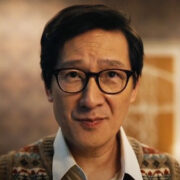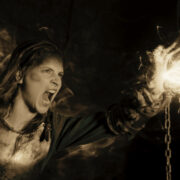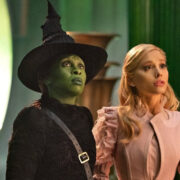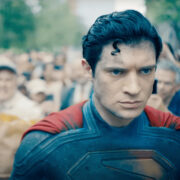The Joker’s Smile, Part 2: A Century Of The Joker
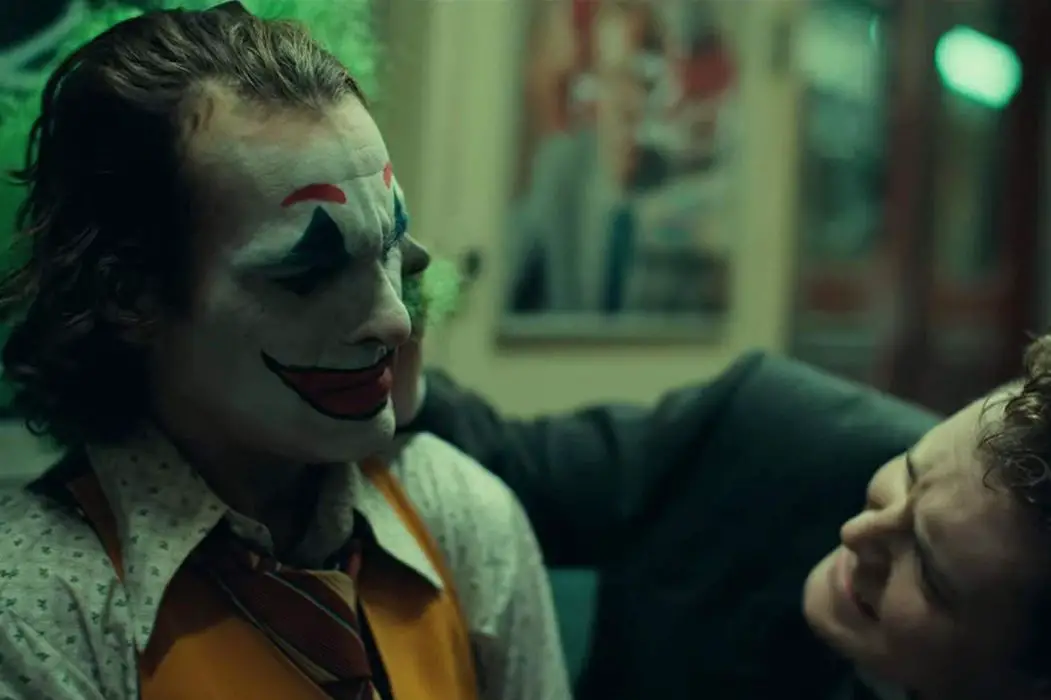
Digital Media Program Coordinator and Professor at Southern Utah University…
With the release of Todd Phillip‘s newest film, the Joker has left behind his traditional role and evolved into a progressive symbol of protest. In this three-part exploration of everyone’s favorite “agent of chaos,” we’ll explore how the Clown Prince of Crime has become, thanks to audiences’ ever-evolving social conscience and critical eye, the newest champion of the 99%. In part 2, the various iterations of the Joker, as well as his predecessor, are explored as part of a changing social environment.
Throughout Batman lore, the Joker has committed horrific atrocities, and yet, audiences have yet to be surprised by the terrible lengths to which he goes. His limitless adaptability is evident in the fact that he has been so convincingly portrayed as someone absolutely evil, as well as someone simply misunderstood, and audiences have consumed both extremes with equally voracious energy. While his adaptability may explain his appeal to storytellers, why is it that audiences also seem to share that fascination, finding themselves so consistently captivated by this chaos-loving clown?
To find an answer to this question, let’s use a simple analogy. Imagine a rotating platform, on which stands the Joker and a mirror. Looking at the mirror, we see the Joker as the foreground, along with whatever is behind him forming the background. As the mirror rotates, the background changes, even as our character remains the same. So it is with the Joker. He remains, but the background (societal issues, priorities, ideas) changes. As these changes occur, fresh eyes look at the character standing in the mirror’s foreground, and make certain assumptions about that character based on the background. New takes on the Joker are, at least in part, a reflection on the changing background, as new reasons to explore him are revealed.
We’ll look at these attributes as we explore the reasons behind his longevity, first by examining some of the general consistencies found in his persona since that first appearance in 1940, then by exploring his various filmic interpretations and the new character attributes brought to light thereby.
Conrad Veidt
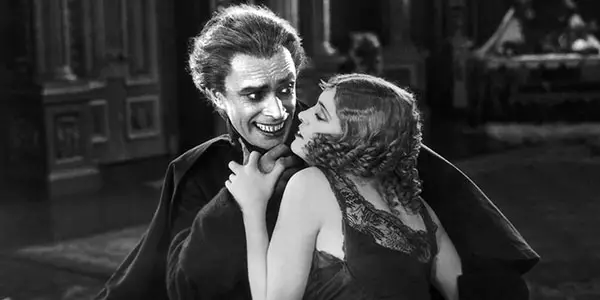
1928. The background of our mirror shows prosperity and technological innovation. The first flight across the Pacific has just taken place. The St. Francis Dam near Santa Clarita collapses, killing at least 400 people, but, undeterred, America’s leadership presses on with plans for the Boulder Dam Project, later to become the Hoover Dam. At a lab in London’s St. Mary’s Hospital, Alexander Fleming is just beginning to realize the wonders of penicillin.
Throughout the “Roaring Twenties” the U.S. economy has doubled. There seems to be no end to the economic prosperity. But even as Mickey Mouse is getting ready to take his first bow, financial disaster is brewing. To the people of this era looking at the mirror, the Joker’s predecessor exhibits physical features they interpret as menacing, a threat to the peace and prosperity shining in the reflection around him.
The story of the Joker begins a full twelve years before Batman #1 was published by Detective Comics in 1940. Universal Pictures, known at the time as Universal Film Manufacturing Company, had found enormous success with two films erroneously marketed as monster movies, both based on the classic French novels The Hunchback of Notre Dame and The Phantom of the Opera. These films were released in 1923 and 1925 respectively, and rather than mess with a winning formula, the studio commissioned another film based on a classic French novel, Victor Hugo‘s L’Homme qui rit, released in England as The Man Who Laughs. Like the previous two films, The Man Who Laughs, released in 1928, was also marketed as a monster movie, and also like the previous two films, it was enormously successful.
In this film, German actor Conrad Veidt portrayed the sympathetic titular character, who proves himself to be a far cry from the monster depicted in Universal’s marketing campaign. Veidt‘s character, Gwynplaine, is a misunderstood man with a physical deformity: when he was a young boy, by cruel order of the king, his mouth had been carved into a grotesque smile. His father, a man of high class, had rebelled against the crown, earning execution for himself and cruel disfiguration for his young son, so the boy would “laugh forever at his fool of a father.”
Despite the cruelty inflicted upon him, Gwynplaine has a heart of gold. His every action is spent in service to the people he loves. Far from the monster the film’s posters depicted, Gwynplaine is as heroic as any character throughout history. Stripped of his physical features and his family’s fortune, the boy had been abandoned in a snowstorm when a chance encounter with a carnival man saved his life.
As an adult, he learns of his heritage, and of the fortune to which he is entitled by birth. The queen, successor to the now deceased king, also learns that Gwynplaine is the true heir to his father’s fortune and places him in the House of Lords. There he finds nothing but a cruel and twisted sense of entitlement, and so renounces his fortune and his heirship, condemning the gross inequality and prejudice among those of high class. Gwynplaine’s incredible speech given in the House of Lords rings as true today as it did when it first poured from Hugo‘s pen.
Even with the strong political messages in the film and its source material, the producers were well aware that the titular character’s ghastly grin would be the real draw for audiences. Consequently, they did everything possible to increase the terror of Gwynplaine’s appearance. Veidt‘s hair was slicked back, giving the character a high forehead. Thanks to a dental contraption, his grin was pulled back as wide as possible. At one point in the film, Gwynplaine even dons white makeup before a performance.
Bill Finger, Bob Kane, and Jerry Robinson, the trifecta responsible for creating the Joker, all credited The Man Who Laughs as the inspiration for the Joker’s appearance. Little did they know that 80 years later, a new film would take the world by storm, one that brought their character far closer to his original source material than his creators would ever have thought possible.
In 1940, the Clown Prince of Crime fully forms in our mirror for the first time with the release of Batman #1.
Cesar Romero
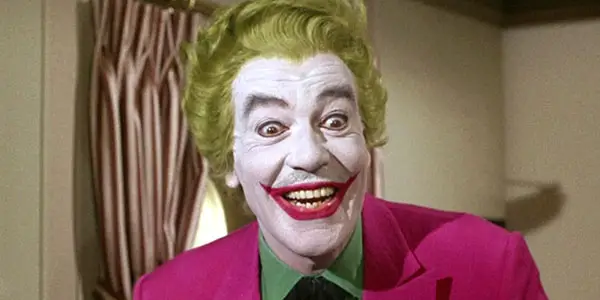
1966. The mirror’s reflection shows a desperate time in the space race, as the Soviet Union’s Luna 9 has just made the first soft landing on the moon. The U.S. has been fighting in Vietnam for a year, and protests are taking place across the country. Dr. Martin Luther King, Jr. leads the Civil Rights movement, while in Oakland, the Black Panther Party is being formed.
Ronald Reagan will be elected as governor of California in June. In September, the show that will become Gene Roddenberry‘s legacy will, for the first time, “boldly go where no one has gone before.” Our foreground character looks slightly less menacing to the people of this era, secure in their faith of American exceptionalism. Almost, perhaps, even funny.
In the mid-60s, the ABC television network commissioned a new series simply titled Batman. A far cry from the previous more serious explorations of the Caped Crusader, the series turned Batman lore on its head with campy humor and hilariously inept supporting characters. Casting Adam West as Batman would prove to be a stroke of genius, as he became the perfect straight man on which the show’s camp would come to depend.
Cesar Romero became the first actor to portray the Joker, famously refusing to shave his mustache while playing the part. Political commentary offered by this version of the Joker took a back seat to his humor, a tongue-in-cheek example being his labeling of Batman’s utility belt as “unconstitutional” in the 5th episode of Season 1.
The Adam West Batman series and movie came on the heels of the period following World War II, one of religious morality and American exceptionalism, as well as an increase in conservative political power. This age would eventually see the election of Richard Nixon as President of the United States and ultimately lead to Ronald Reagan occupying the office.
A swatch of conservative-leaning television paraded across the airwaves with shows such as The Andy Griffith Show, Gunsmoke, and of all things, Adventures of Superman. The liberal reaction to these changes came in the form of competing television shows like Star Trek and Rowan and Martin’s Laugh-In, where even Nixon made an appearance that many credited with helping him win the presidency.
Somewhere in the middle was Adam West‘s Batman. One of the more direct and obvious political references targeted Ronald Reagan himself, who was governor of California when the show aired. Stanley Ralph Ross, the writer behind the episode “The Entrancing Dr. Cassandra,” famously wanted to call Cassandra’s weapon “the Ronald Ray Gun.” The name never saw the final cut, however, and was changed to the Alvino Ray Gun. Batman espoused many other liberal philosophies throughout the show, including his take on prison reform, civil rights, and other issues.
Batman’s philosophies were often mere ancillary tools for the show’s camp, however, and the show was not necessarily of liberal ilk. Considering Batman’s position as a wealthy capitalist who, through violent force, upholds the class system that perpetuates his wealth, one wouldn’t be remiss in thinking the character stood as a symbol of the conservative era in which the show aired, even despite the sometimes liberal-leaning philosophies he would sometimes express.
Further, the government officials Batman unquestioningly (and inexplicably) trusts are depicted as little more than bumbling fools, a position well in line with a desire for smaller government: “Batman was a cultural reflection of the growing conservative political rhetoric in America during the late-1960s and 1970s, in which right-wing politicians, including Richard Nixon, and ultimately Ronald Reagan, characterized the state as weak and inefficient, championing free enterprise and competition as a scale of social good.”
While most of the show was decidedly apolitical, an exception was the two-part episode Hizzoner the Penguin and Dizzoner the Penguin (episodes 17 and 18 of season 2), in which politics takes center stage as the Penguin decides to run for Mayor of Gotham City. He understands very well how to run political circles around Gotham’s uninformed citizenry: “We’ll give the voters of this city the kind of campaign that they want. Plenty of girls and bands and slogans and lots of hoopla! But remember, no politics. Issues confuse people. A big smile, a hearty handshake, and a very catchy campaign song, that’s the way to win an election!” Later he says: “Politics are wonderful. I can use all my lowest, slurpiest tricks, but now they’re legal. I should’ve been a politician years ago.”
In contrast, Batman believes in honest campaigning. He explains: “I want to conduct a campaign that deals with the issues. I’m convinced the American electorate is too mature to be taken in by cheap vaudeville trickery. After all, if our national leaders were elected on the basis of tricky slogans and brass bands and pretty girls, our country would be in a terrible mess, wouldn’t it?”
Batman’s position is completely baffling considering how often the citizenry show the exact opposite tendency, an example of which is their being duped into trusting the Penguin enough to make him mayor after a few cheap “moral” acts that apparently rendered mute his long history of criminal action. In the end, Batman’s political victory is equally inexplicable, and chalked up to the citizens being “better” than we assumed, despite a complete lack of evidence to support this claim. To be fair, of course, this ending was perfectly in line with the campy humor of the show. Still, it should give one pause to consider how clear the writing on the wall must have been for a television show to so accurately predict how campaigns would evolve over the next half century.
No matter where the 1960s Batman lies in terms of social commentary, one thing is certain: it defined Batman and his villains, and provided the foundation upon which every other iteration has been built. Without Adam West and Cesar Romero, there would have been no Michael Keaton and Jack Nicholson, no Christian Bale and Heath Ledger, and certainly no building interest in a multifaceted villain that would eventually lead to Joaquin Phoenix donning the white makeup.
Jack Nicholson

1989. In the reflection is nascent political chaos. The Berlin wall is slowly crumbling. Protests in Tiananmen Square will soon culminate in a massacre. In America, Bill Cosby stars in the most popular show on television. NASA, struggling to recover from the Challenger disaster, is gearing up to send Galileo to Jupiter, but it won’t arrive at its destination for another fourteen years.
Reagan‘s recently concluded presidency had been virulently anti-government, even while it used government power – or its withdrawal – to hugely benefit corporations and money brokers, to the tune of “deregulate, deregulate, deregulate.” Dick Cheney, a man who will soon begin building what will eventually become an impressive array of connections with various defense contractors, has just become the Secretary of Defense, and Newt Gingrich has begun laying out a highly partisan, pro-big business, anti-compromise political strategy in the House of Representatives. The Joker, with his custom suit and fancy toys, seems to our new viewers in this era to be corporate evil incarnate.
Toward the end of Ronald Reagan‘s presidency, Warner Bros. sought to reignite the superhero genre with a new film to be helmed by director Tim Burton, who had found recent success with the decidedly nontraditional Beetlejuice. Reagan‘s deregulation campaign was front and center in American politics, and the gap between the wealthy and the rest of the population was beginning to grow. It’s no surprise that the film’s villain comes from the corporate world, and that the fuel he uses to run his nightmarish schemes is money, culminating in dumping $20 million into a crowd of people before killing them with “Joker gas.”
Jack Napier, later the Joker, is a crook from the start, paying off corrupt cops to help his business interests in competition with Grissom, an ex-boss he wants to make a rival. Corporate corruption among Grissom and his pals is an open secret, well known to the police and to the press, and yet their shady business dealings continue unabated. Each of the wealthy elites to whom we are introduced are palpably depicted as criminals, save of course Bruce Wayne himself. With Wayne providing a precarious counterbalance, the film shies away from fully equating corruption to wealth, something Burton would never hesitate to do in his later films. As observed by Gotham reporter Alexander Knox, played by Robert Wuhl: “The rich. Know why they’re so odd? Because they can afford to be.”
As Jack Napier becomes the Joker, privilege is his first target as he defaces fine art, poisons the city’s cosmetics supplies, and attacks many of Gotham’s more affluent citizens. Then he seems to switch tactics and target the everyman, luring the masses to a festival with the promise of money, and gassing them. The parallel to the issues of the time are clear: the growing wealth gap is a universal concern, masterfully formed into a perfect villain embodied by Jack Nicholson‘s Joker, uniquely positioned as a symbol of terror to either side of the income divide.
With Nicholson‘s interpretation, the Joker as a villain took a much darker turn compared to his predecessor. Burton‘s vision required that Batman be a relatable, human character, and so shifted the focus to Bruce Wayne rather than his alter ego. Naturally, the villain received the same treatment, becoming far more human, and far more disturbing. Nicholson‘s Joker not only succeeded in giving a villainous face to corporate America, but at the same time, was greatly successful in redefining the Joker as a character. Adding a sinister flair to Romero‘s trademark humor worked brilliantly.
While Nicholson‘s Joker was as perfect as any before or since, Burton‘s time at the helm did not succeed in fully rewriting the formula for superhero films in general. 1989’s Batman was a success, but its sequel went even darker and scared away the corporations run by a wealthy elite that both films had not-so-quietly criticized. Variety reporter Anita M. Busch explains:
Over the course of directing the first two ‘Bat’+ movies, offbeat auteur Tim Burton had taken the comic book tale from ominous to ominous, creepy and violent. The sequel was so dark and violent that parents’ groups lashed out at the studio, its product licensees and its promotional partner, McDonald’s Corp. Marketers cringed and retailers bristled as Batman product moved slowly off shelves; McDonald’s, the largest fast-food chain in the world, changed its film promotional strategy after criticism.
In the end, Warner Brothers decided to bring in another director to helm the third film, which resulted in more inadvertent campy humor than was purposely employed in the 60s show. For a time, superhero films stayed as far away from these darker themes as possible, not wanting a repeat of the underwhelming financial earnings from Batman Returns. However, to a modern viewer familiar with the 2016 presidential campaign, Burton‘s sequel rings true:
In a development with absolutely no current cultural or political resonance… this marriage of convenience between a crazy-haired, evil billionaire who enters the political arena solely for his own mercenary ends and a rage-filled pervert launching an unlikely campaign for political office comes to an end when Batman tapes the Penguin bragging about his contempt for the people of Gotham and then plays it for the horrified populace.
The terrifying difference between fiction and reality, however, is that while Gotham’s citizenry rejected the “rage-filled pervert” upon hearing the incriminating tapes, the American citizenry elected him as President in 2016.
Heath Ledger

2008. Financial chaos. In the background of our mirror’s reflection, the country’s banks are reporting billions upon billions in losses. An oil crisis is crippling the country, with fuel averaging $4.11 per gallon. CERN’s Large Hadron Collider has officially opened in Switzerland, and Elon Musk‘s SpaceX company has recently launched Falcon 1, history’s first private spacecraft.
Political partisanship, still on the rise in America since Gingrich‘s tenure in Congress, has contributed to the unprecedented divide in voter priorities between the left and the right, as Barack Obama becomes the first African-American President in U.S. history. The new viewers of this era would undoubtedly see the imposing Joker standing in the reflection’s foreground as a terrifying figure threatening to tip the scales of an already precarious societal balance.
Entertainment Weekly reporter Anthony Breznican explained why Heath Ledger‘s Joker set the bar for portraying villains when he wrote:
Villain roles are attracting top tier actors… For that, you can probably blame the Joker, and his Oscar for The Dark Knight… Something may be going on with the audience, too. Money is tight in a stagnant economy, and our political divide can be summed up as one-for-all versus dog-eat-dog. Everyone feels overworked and undervalued. When people stop believing in the system, they start looking for a way to beat it. If the meek cannot inherit the earth, why not scorch it?
With 9/11 still casting a long shadow, the war on terror escalating, and rising tension in an increasingly partisan country, the greatest fear of the mid-2000s was loss of order. Enter Heath Ledger‘s Joker: “an agent of chaos.” As America declared itself the world’s protector against terrorism, the Joker stood as a villain arguing for terrorism as something preferable to a powerful institution enforcing its ideals, the institution in question being Batman in the film, America in real-world society.
Batman, like America, faces a no-win scenario. No matter how hard he hits, the Joker simply stands up again, laughing in his face. “You have nothing to threaten me with. Nothing to do with all your strength.” As Den of Geek editor David Crow writes:
Ledger embodied that to terrifying effect. Unlike Nicholson, who made the role an extension of his silver screen persona, Ledger disappeared into the character. His Joker was not scarred by chemicals, but from a Glasgow smile carved onto his face. And like The Killing Joke, he has multiple stories about how those scars were earned, each a lie meant to unsettle victims he soon plans to carve equally grisly grins into.
Ledger‘s Joker vehemently denies being crazy, insisting instead that he’s just very good at what he does. Of course, when it’s convenient, he tells the injured Harvey Dent that he is crazy; just “a dog chasing cars.” This back and forth, like the contradictory stories he tells about his scars, strongly suggests that nothing the Clown Prince says is meant to convey truth, but rather, to keep it only for himself. He’s always playing someone.
The Joker’s motivation is commonly assumed to be fully revealed in Alfred’s line, delivered by actor Michael Cain: “Some men just want to watch the world burn.” However, Joker never actually reveals his true intentions, other than the cryptic “it’s about sending a message.” Everything he says or does is calculated to get a reaction, either from his victims or from Gotham City’s general populace. A prime example is when he’s able to get out of lockup by baiting the guarding officer into attacking him.
Educator Justine Toh pointed out the parallels between Christopher Nolan‘s trilogy and the war on terror, and argued convincingly that Batman and Bruce Wayne represent America, fighting enemies that threaten the stability of the status quo. A simple example is the fact that Wayne Enterprises, like the US government (a parallel made clear when Earle, played by Rutger Hauer, refers to it as an “empire”), manufactures weapons of war on a massive scale, but Bruce Wayne rationalizes the undoubtedly high human cost of these pursuits by convincing himself of Batman’s need for those weapons in order to pursue his own “righteous” causes.
In the same vein, political leaders in the US tend to excuse the heavy wielding of an extremely weaponized iron fist in advancing their own agenda as a “righteous” cause. As Toh explains: “Batman’s righteous task is to clean up Gotham by removing its corrupt elements, a fictional parallel for the righteousness of the US’s campaign to promote democracy in the Middle East.” (Toh, p. 132) There are several examples throughout Nolan‘s trilogy that help to illustrate this point.
In Batman Begins, it’s revealed that Thomas Wayne built the city’s public transit system to route through Wayne Tower as its central hub, a sure way to ensure the masses are never able to forget their corporate overlord’s benevolence. In The Dark Knight, Bruce Wayne/Batman seems to have no problem using criminals to meet his needs, provided they don’t present a threat to Gotham, such as the smugglers who help him “extradite” Mr. Lau from one of the upper floors of a Beijing skyscraper. Further, he states outright that he has no problem with buying elections: “One fundraiser with my pals, and you’ll never need another cent.”
The third film in Nolan‘s trilogy, The Dark Knight Rises, would be released in 2012. This final entry would continue the premise explored in the first two films as a deceptively simple story about the war between the privileged and the populace. In this concluding film, Christian Bale‘s Bruce Wayne maintains that the world is not ready for a machine that generates pure, clean energy, while Marion Cotillard‘s Miranda Tate, later revealed to be Talia al Guhl, insists it’s the right thing to do.
Considering his class, the reason behind Wayne’s position is obvious: economics. Going public with the limitless clean energy technology would bankrupt much of the wealthy elite, completely reversing the balance of world power. In this scene, Bruce Wayne, and by extension Batman, reveals his goal: to keep the power within the hands of the 1%.
Representing the rest of the populace is Bane, played by Tom Hardy, who by contrast discerns a great untapped power in the 99%. In an early scene, Bane is conversing with one of the wealthy businessmen who has helped to finance his enterprises. When questioned by one of his bodyguards, the financier c*ckily asserts “I’m in charge here.” Bane proves the opposite by simply placing his open hand on the financier’s shoulder. In most cases, a hand on the shoulder is a form of greeting or an effort to offer comfort. Simply based on context, however, his movement is as implicitly violent as if he had pulled a gun.
With this silent threat, Bane instantly reveals the true balance of power, both within the film and as a larger metaphor for the 99%. Shocked, the financier exclaims in his own defense: “I’ve paid you a small fortune!” To which Bane mockingly replies: “And this gives you power over me?” After espousing himself as the “necessary evil” of “Gotham’s reckoning,” Bane ends the financier’s control, of anything, with a simple flick of his wrist.
Later, as Bane is proving himself to be Batman’s physical superior during a fight scene, Bane explains his position by using darkness as a metaphor for tools that have heretofore been used by oppressors against the poor, tools that will soon be used against their former masters. Bane’s words are targeted directly at the affluent Bruce Wayne, whom Bane knows hides beneath the black cowl. As Batman uses one of his gadgets to shut off the lights in hopes of finding an advantage, Bane openly mocks him. “Oh, you think darkness is your ally? But you merely adopted the dark. I was born in it. Molded by it. I didn’t see the light until I was already a man. By then it was nothing to me but blinding. The shadows betray you because they belong to me!”
Bane’s words offer a clear warning to the affluent, a torch which would later be carried by protesters channeling 2019’s Joker: that the people, molded and strengthened by a compulsory resistance to the oppressive shadows of poverty and repression, will soon arise.
Of course, only Christopher and Jonathan Nolan know how Ledger‘s Joker would have played his cards in the trilogy’s culminating battle between the elite and the masses, but we can speculate. One of his principle messages in The Dark Knight is that the people, if left without order, will “eat each other.” When Bane promotes anarchy from the rubble that remains of Gotham after he blows it up, and reveals to the people the lies upon which their government was based, the people descend into chaos just as the Joker predicted, sentencing to death everyone they can find who bought into the previous system.
With Batman’s victory comes a restoration of the status quo, and the implication that the people would have simply destroyed themselves even if Talia’s bomb had failed in its ultimate purpose. In that implication, we can clearly see the overall message of the trilogy, as explained by Toh: “[C]itizens are incapable of governing their own affairs and need a strong, conservative leader.” (Toh, 2010, p. 135)
While greatly successful, Nolan‘s Batman films, like Burton‘s, did not fully succeed in rewriting the formula for superhero films, as ScreenRant’s Craig Elvy explains:
Given the critical and commercial achievements of The Dark Knight, many might’ve expected Nolan’s tale of Caped Crusader vs. Agent of Chaos to herald a new era for comic book movies; a shift away from the colorful blockbusters that were beginning to fall flat, and a move towards a grittier approach that catered towards the adult market. This simply wasn’t the case, and Nolan’s The Dark Knight trilogy stands out as an anomaly in the history of superhero cinema, rather than a catalyst for change… Despite its more humble beginnings, the Marvel Cinematic Universe proved to be the true cinematic game-changer, moving the superhero genre towards a shared universe system that many others would try to emulate. Stylistically, however, the MCU followed the same family-friendly blockbuster format that existed long before The Dark Knight, and this would continue to be the standard moving forward.
Joaquin Phoenix

2019. The reflection shows impeachment proceedings against a president elected at least in part due to interference from another country. Gingrich‘s dream of no-compromise, corporate-friendly politics has culminated in Donald J. Trump as President of the United States. Constant access to internet-enabled smartphones has brought the world closer together than ever before, even as the unprecedented political divide tears the country apart.
The looming threat of climate change threatens humanity’s survival. And yet, through the chaos, we see a glimmer of hope in increased compassion, as social priorities continue to change. Rather than a threat to order or an easy target for mockery, modern viewers looking into the mirror are able, for the first time, to see beyond the Joker’s menacing appearance, to question the oppressive system that brings people to such ends, and ultimately, to feel sympathy.
Many have said Todd Phillips‘ newest film 1) gives Joker an unnecessary backstory, and 2) that doing so takes away the most interesting aspects of the character. The reality is that these arguments couldn’t be farther from the truth, and both deserve their own rebuttal.
First, to the argument that the film provides an unnecessary backstory: the film does not provide the backstory for Joker, but rather a (singular) possible backstory, one of many potential explorations on how the Joker, in our modern society, might come to be. This is a fantastic idea worthy of exploration, offered in the film as a new look into what should be an ever-evolving character. Far from being “unnecessary,” the new precedent Joker sets is absolutely essential to comic book films becoming cinema the likes of which even Scorsese and Coppola would approve:
Marvel movies, in their eye-popping and often quite enthralling way, have the quality of being finite. There’s no hidden layers to anything that happens in them. They scarcely pretend to have those layers – not the way a movie like La La Land or The Social Network or 12 Years a Slave or Lady Bird does. Or the way that Joker, the anti-comic-book comic-book movie, does. To point this out doesn’t need to be a put-down. But Scorsese and Coppola are asking something elemental: Do we want a movie culture where everything is programmed and scannable, with no hidden levels, so that movies no longer reflect the mystery in ourselves? Some might say, “We do!” But I would say be careful what you wish for. Instead of rising up to damn what Scorsese and Coppola have said, maybe we should spend a few moments considering why they said it. Are Marvel movies cinema? We’ll be a healthier culture if we let the debate begin.
The fact is, superhero films could only benefit from allowing the storytellers to explore the deeper (and sometimes darker) facets of their respective universes in exactly the same way the Joker has done for DC. Hopefully this time, Phillip‘s version of the Joker will succeed in rewriting the formula for superhero films moving forward, one that is not necessarily mutually exclusive with the standard recipe.
Joker was made as a standalone film, meant to explore a certain aspect of the comic book universe. Both the Marvel and DC cinematic universes can persist in their expansion efforts with big-budget blockbusters, while also continuing in the trend Joker has started. Elvy writes:
Joker is the most radical comic book movie yet, and by a comfortable distance. It perhaps also wouldn’t be a stretch to say that Joker defies even the traditions of major studio movies in general… [It] takes th[e] expectations and makes confetti out of them, laughing all the while… Joker makes Batman’s criminal branding in Batman V. Superman or the Sokovia Accords debate in the MCU look like feeble attempts to introduce elements of conflict into otherwise straightforward characters… The best outcome would be if Joker proved to both filmmakers and studios that comic book movies needn’t stick to the same story structure and that, in some cases, they don’t really even need to be action movies at all in the standard sense. Many might’ve predicted that a Joker solo movie wouldn’t work without Batman, or without a story entrenched in the wider DC universe or without an adversary for the Clown Prince to fight against, but Joker succeeds without all three, simply as a character study of a fascinating comic entity.
To the argument that the film takes away everything that makes the Joker interesting: it’s actually a perfect Joker film, even under the criteria established by previous entries in which he is featured. Arthur Fleck’s own mental illness throws into question the accuracy of everything presented, as we’re repeatedly duped into thinking what we’re watching is real, only to find out such was rarely the case. We’re even left wondering if the beginning is actually the end, or vice versa, as we’re told that Fleck has been locked up in the mental institution prior to the film’s events.
The film is rife with subtle hints that much of what we’re watching isn’t real. We’re never explicitly told exactly how much is delusion, or simply the Joker telling another version of his story to his psychiatrist, the same way Ledger‘s Joker would ask and answer his own question: “Wanna know how I got these scars?” Fleck’s solipsism is part of what makes this newest iteration a perfect Joker film: even though it masquerades as an origin story, it’s just as twisted as any “joke” we’ve come to expect from the Clown Prince of Crime.
Both Todd Phillips and Joaquin Phoenix said as much when asked about the “true” meaning of Joker, or whether they ever really “got” the titular character. As Phoenix explains: “[T]here wasn’t anything to get… The character is undefinable and so there wasn’t a thing to get… When we started to define things, it sucked the life out of it.”
Further, if the Joker is indeed pulling us along, fabricating the story told throughout the film, then he is willingly highlighting the social stereotypes of evil proposed by sociologist Orrin E. Klapp, completely tearing apart society’s label of “villain,” another stroke of genius in Phillips‘ film. In short, the Joker is very much the “unreliable narrator” we’ve come to expect him to be.
While these elements alone make the film a masterwork, its treatment of mental illness and societal issues put Joker in a class of its own. Fleck is a desperate loner barely surviving his day-to-day life when the city cuts funding to the already inadequate social services helping him, thereby also cutting the proverbial thread by which he hangs. Elvy continues:
No one’s quite sure whether depression and anxiety is becoming more commonplace, or whether it has always been this prevalent and only now being recognized, but one thing that can be said with confidence is that state health services are woefully equipped to deal with these conditions and social attitudes leave plenty of room for improvement.
Ultimately, Phillips‘ film owes its success to an evolving social conscience. While politics are part of the world in which Arthur Fleck becomes the Joker (garbage strike, income inequality), front-and-center is the inherent cruelty in turning a blind eye toward, or actively antagonizing, those with mental illness.
The film has two villains, each of which has a motive directly in conflict with the other. The first is Fleck himself, villain to the status quo, who tosses a proverbial match by killing three affluents. As he writes in his journal/joke book: “The worst part about having a mental illness is people expect you to behave as if you don’t.” In trying to make his way in an unjust world, Fleck is repeatedly knocked down, until finally, he defends himself, inadvertently igniting the previously dormant coals of Gotham’s downtrodden. Finally taking the control that had always been stolen from him, Fleck embraces the violence and becomes the Joker.
The film’s second villain is the very thing that makes Fleck’s descent not only understandable, but worthy of celebration. Joker is a comic book movie that shines a light on the greatest failing of all comic book movies: the celebration and hero-worship of individuals who uphold the status quo, no matter how corrupt. As Ledger‘s Joker said: “Nobody panics when things go according to plan. Even if the plan is horrifying.” In Joker, we see Fleck, later the Joker, as a sympathetic loner who makes a reasonable choice, given the limited options imposed on him by the film’s second, and far more dangerous villain, who will eventually be personified as Batman.
It’s not a mistake that wealth inequality, and rebellion against it, plays a pivotal role in Joker. Similar to Bane’s and Talia’s ambition in The Dark Knight Rises, those who eventually become the Joker’s followers are the 99%: people ready and waiting to rise against classism. The difference in audience perception of Nolan‘s Bane and Talia compared to Phillips‘ Joker is two-fold: an evolved social consciousness (due at least in part to the LGBTQIA*, #MeToo, and Black Lives Matter movements), and the depiction of the rebellion through the lens of mental illness, a far more sympathetic point of view compared to the one presented by Bane and Talia.
In putting on the makeup, Arthur Fleck as Joker takes on the same mantle traditionally held by Bruce Wayne as Batman, summarized most effectively by Katie Holmes‘ Rachel Dawes in Batman Begins when she identified the Caped Crusader as Wayne’s true identity, rather than the other way around: “This is your mask. Your real face is the one that criminals now fear… Maybe someday, when Gotham no longer needs Batman, I’ll see [Bruce] again.” In much the same way, when we no longer need the Joker to be a symbol for desperately needed change throughout the world, he may resume his traditional role as the campy, exciting, or ultra-violent arch nemesis audiences remember. For now, however, he’s exactly where we need him to be.
With Phoenix‘s interpretation, the Joker has come full circle: from a sympathetic man with a physical disability in 1928’s The Man Who Laughs, to a sympathetic man with a mental disability in 2019’s Joker. Finally, in this film, we see the full adaptability of the character. Joker has spent the better part of his 80 years engaged in despicable, evil acts, fulfilling roles from various writers prompted by the social mirror’s ever-changing background. And yet, this new interpretation has now become a symbol for protesters around the world as they fight for a better life. As comic book historian and writer William Blanc explains:
Todd Phillips’ film about the Joker has a real evocative power. It echoes a form of protest against a political system that people believe is inflexible… At the end of Todd Phillipps’ film, a bit like at the end of V for Vendetta, everyone putting on the same mask is their way of coming together as a group, to create a collective, to not feel alone with your struggle… The Joker is a plastic character and is not representative of the right or the left… [Phoenix’s Joker] speaks mainly of being alone, separated from any sense of a collective. This isolation is a real contemporary evil.
90 years on, the newest interpretation of the Joker depicts him as a character closer to his inspiration than any before him, a symbol for persons or groups systemically oppressed. Like Gwynplaine, Phoenix‘s Joker is sympathetic, and rises as a voice for the downtrodden. And as we can see from the Joker faces appearing in protests around the world, people are hearing the message.
Sources, Additional Reading
Bean, T. (2019, October 22). These Numbers Tell Us ‘Joker’ Will Eclipse $1 Billion At The Box Office. Retrieved from Forbes: https://www.forbes.com/sites/travisbean/2019/10/22/these-numbers-tell-us-joker-will-hit-1-billion-at-the-box-office/#448a496c716d.
Busch, A. M. (1995, May 1). Dark Knight Becomes ‘Bat’ Lite. Variety.
Bump, P. (2016, November 25). The campaign that predicted 2015 Trump to a T: Batman vs. The Penguin. The Washington Post. Retrieved from The Washington Post: https://www.washingtonpost.com/news/the-fix/wp/2016/11/25/the-campaign-that-predicted-2016-to-a-t-batman-vs-the-penguin/.
Breznican, A. (2013, November 8). A Villain will Rise. Entertainment Weekly (1284), p. 46.
Crow, D. (2019, September 26). Joker: 6 Actors Who Have Played the Clown Prince of Crime. Retrieved from Den of Geek!: https://www.denofgeek.com/us/movies/joker/257581/joker-6-actors-who-have-played-the-clown-prince-of-crime.
Elvy, C. (2019, October 20). Joker Finally Finishes What The Dark Knight Started. Retrieved from ScreenRant: https://screenrant.com/joker-movie-dark-knight-comic-book-genre-reinvent/.
Elvy, C. (2019, October 11). Joker Proves Comic Book Movies Can Be So Much More. Retrieved from ScreenRant: https://screenrant.com/joker-comic-book-movies-better/.
Gleiberman, O. (2019, October 23). Are Martin Scorsese and Francis Ford Coppola Right About Marvel? Retrieved from Variety: https://variety.com/2019/film/news/martin-scorsese-francis-ford-coppola-right-about-marvel-1203381088/.
Gould, C. (2011, July 12). Batman’s Cultural Impact: Promoting Great Society Values. Retrieved from Pop Matters: https://www.popmatters.com/139556-batmans-cultural-impact-promoting-great-society-values-2496052159.html.
Kaur, H. (2019, November 3). In protests around the world, one image stands out: The Joker. Retrieved from CNN: https://www.cnn.com/2019/11/03/world/joker-global-protests-trnd/index.html
Klapp, O. E. (1954, February). Heroes, Villains and Fools, as Agents of Social Control. American Sociological Review, 19(1).
Libbey, D. (2019, October 3). Joker Ending Explained: What Really Happened? Retrieved from CinemaBlend: https://www.cinemablend.com/news/2481483/joker-ending-explained-what-really-happened.
McNab, J. (2019, October 10). 5 Reasons ‘Joker’ Is A Terrible Joker Movie. Retrieved from Cracked: https://www.cracked.com/article_26760_5-reasons-why-joker-terrible-joker-movie.html.
Mounier, J.-L. (2019, October 24). From Beirut to Hong Kong, the face of the Joker is appearing in demonstrations. Retrieved from France24: https://www.france24.com/en/20191024-from-beirut-to-hong-kong-the-face-of-the-joker-is-emerging-in-demonstrations
Newby, R. (2019, October 3). ‘Joker,’ ‘The Man Who Laughs’ and the Birth of a Villain. Retrieved from The Hollywood Reporter: https://www.hollywoodreporter.com/heat-vision/joker-man-who-laughs-birth-a-villain-1245195.
Parks, M. (2019, April 18). Mueller’s Report Shows All The Ways Russia Interfered In 2016 Presidential Election. Retrieved from NPR: https://www.npr.org/2019/04/18/714810702/muellers-report-shows-all-the-ways-russia-interfered-in-2016-presidential-electi.
Phillips, T., & Phoenix, J. (2019, October 23). Joaquin Phoenix and Todd Phillips Go Deep on the Challenges of Making ‘Joker’ and That Ending. (S. Weintrub, Interviewer) Retrieved from https://collider.com/joker-interview-joaquin-phoenix-todd-phillips/.
Purcell, R. D. (2017, July 4). Remembering Adam West: Batman and 1960s America. Retrieved from Los Angeles Review of Books: https://blog.lareviewofbooks.org/essays/remembering-adam-west-batman-1960s-america/.
Rabin, N. (2016, December 20). Why Batman Returns Deserves its Cult Following. Retrieved from Rotten Tomatoes: https://editorial.rottentomatoes.com/article/why-batman-returns-deserves-its-cult-following/.
Remarks by President Trump at a Salute to America. (2019, July 4). Retrieved from The White House: https://www.whitehouse.gov/briefings-statements/remarks-president-trump-salute-america/.
Reyes, M. (2019, October 21). Why Joker Should Lead to an Anthology Rather than a Franchise. Retrieved from CinemaBlend: https://www.cinemablend.com/news/2482765/why-joker-should-lead-to-an-anthology-rather-than-a-franchise.
Rosenbaum, D. E. (2004, September 28). A Closer Look at Cheney and Halliburton. Retrieved from The New York Times: https://www.nytimes.com/2004/09/28/us/a-closer-look-at-cheney-and-halliburton.html.
Toh, J. (2010). The Tools and Toys of (the) War (on Terror): Consumer Desire, Military Fetish, and Regime Change in Batman Begins. In A. Froula, Reframing 9.11: Film, Popular Culture and the “War on Terror” (pp. 127-140). Continuum.
Joker was released in the U.S. on December 13, 2019. For international release dates, see this page.
https://www.youtube.com/watch?v=-_DJEzZk2pcDoes content like this matter to you?
Become a Member and support film journalism. Unlock access to all of Film Inquiry`s great articles. Join a community of like-minded readers who are passionate about cinema - get access to our private members Network, give back to independent filmmakers, and more.
Digital Media Program Coordinator and Professor at Southern Utah University and Southwest Technical College; M.Ed.; Author at Labyrinth Learning and Film Inquiry. Passionate educator of film theory and history. World-class nerd with a wide array of interests and a deep love for many different fandoms.


